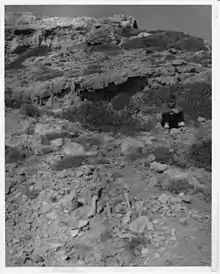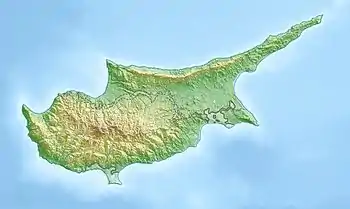Aetokremnos
Aetokremnos is a rock shelter near Limassol on the southern coast of Cyprus. It is situated on a steep cliff site c. 40 m (131.23 ft) above the Mediterranean sea. The name means "Cliff of the eagles" in Greek. Around 40 m2 (430.56 sq ft) have been excavated and out of the four layers documented, the third is sterile.
 Aetokremnos upon its discovery, 1960, with fossil remains in the foreground | |
 location in Cyprus | |
| Location | near Limassol |
|---|---|
| Region | southern coast of Cyprus |
| Coordinates | 34°34′14″N 32°59′26″E |
| Type | limestone |
| History | |
| Periods | Mesolithic |
| Associated with | Paleo humans |
The site contains mainly bones of the late Holocene dwarf fauna, such as pygmy elephants (Elephas cypriotes), the Cyprus Dwarf Hippopotamus (Hippopotamus minor) and artifacts (c. 1,000 flints including thumbnail scrapers of the Mesolithic type). There are no bones that show marks of butchery, but an unusually high frequency (30%) of burned bones. The pygmy hippos make up c. 74% of the bones, followed by fish remains (25%) and birds, mainly bustards. Dwarf elephants are comparatively rare (3 individuals). The presence of fallow deer (4 bones) and pig (13 bones) is puzzling, since these animals are thought to have been introduced only in the Neolithic period.[1]
According to the excavators, hearth remains are found in the layer containing the bone beds of the extinct megafauna. This would make it the oldest site on the island and evidence of Epipalaeolithic occupation. The original 31 radiocarbon dates put the date of the bones at c. 12,500 years BP. and suggest a short-term occupation. These dates have been challenged as the excavators considered the nine bone dates to be the least reliable and did not agree with the dates of the stratigraphy where they were found. As of 2013 there are now 36 radiocarbon dates of which 13 were taken from animal bones (pig and hippo). A 2013 report states that even discarding these and relying on the other 23 determinations on charcoal, sediment and shell "we reaffirm our original interpretation of a relatively short occupation of some 300 years centered around 11,775 years BP, with a range of 11,652 to 11,955 years BP at one standard deviation, or 11,504 to 12,096 years BP at two standard deviations. This is in general accord with Manning’s (2013:501 to 503) masterful compilation of all early Cypriot radiocarbon determinations, in which he places Aetokremnos within an approximate 12,950 to 10,950 years BP range while also preferring a somewhat longer occupation than we presented."[2][3]
There are other deposits with bones of pygmy elephants and hippopotami on the island, but these do not contain artifacts.
References
- "akrotiri aetokremnos 20 years later". Academia edu. Retrieved January 4, 2017.
- Simmons, Alan H. (2013). "Akrotiri-Aetokremnos (Cyprus) 20 Years Later: An Assessment Of Its Significance" (PDF). Eurasian Prehistory. 10 (1–2): 139–156.
- "THE FIRST HUMANS AND LAST PYGMY HIPPOPOTAMI OF CYPRUS" (PDF). Asor.org. Archived from the original (PDF) on June 6, 2016. Retrieved January 4, 2017.
Sources
- Simmons, Alan H. (2001). "The first humans and last pygmy hippopotami of Cyprus". In Swiny, Stuart (ed.). The earliest prehistory of Cyprus: From colonization to exploitation (PDF). Cyprus American Archaeological Research Institute Monograph Series. 2. Boston: American Schools of Oriental Research. pp. 1–18. Archived from the original (PDF) on 2016-06-06. Retrieved 2012-04-24.
- Simmons, Alan H. (1999). Faunal extinction in an island society: pygmy hippopotamus hunters of Cyprus. Interdisciplinary Contributions to Archaeology. Springer. ISBN 0306460882.
- Grayson, Donald K. (2000). "Faunal extinction in an island society: Pygmy hippopotamus hunters of Cyprus". Geoarchaeology. 15 (4): 379. doi:10.1002/(SICI)1520-6548(200004)15:4<379::AID-GEA7>3.0.CO;2-E.
